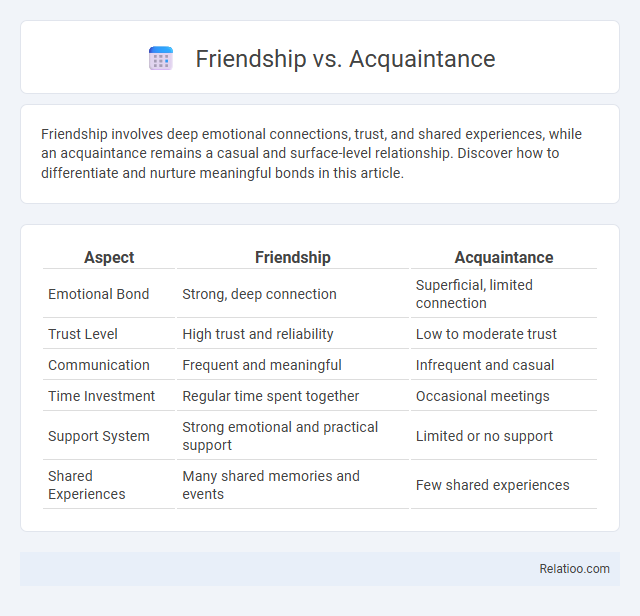Friendship involves deep emotional connections, trust, and shared experiences, while an acquaintance remains a casual and surface-level relationship. Discover how to differentiate and nurture meaningful bonds in this article.
Table of Comparison
| Aspect | Friendship | Acquaintance |
|---|---|---|
| Emotional Bond | Strong, deep connection | Superficial, limited connection |
| Trust Level | High trust and reliability | Low to moderate trust |
| Communication | Frequent and meaningful | Infrequent and casual |
| Time Investment | Regular time spent together | Occasional meetings |
| Support System | Strong emotional and practical support | Limited or no support |
| Shared Experiences | Many shared memories and events | Few shared experiences |
Understanding the Concepts: Friendship vs Acquaintance
Friendship involves deep emotional bonds, trust, and mutual support, while acquaintance relationships are more superficial and limited to casual interactions. Understanding the concepts of friendship versus acquaintance helps you recognize the different levels of connection and emotional investment people have in your life. Evolution of these relationships often depends on shared experiences and time, transforming acquaintances into meaningful friendships.
Key Characteristics of True Friendship
True friendship is characterized by deep trust, emotional support, and mutual understanding, distinguishing it from mere acquaintance, which often lacks emotional intimacy and commitment. Unlike acquaintances, real friends evolve alongside you through shared experiences, adapting to life changes while maintaining a strong, genuine connection. Your closest friendships thrive on consistent communication, empathy, and a willingness to invest time and effort into nurturing the bond.
Distinguishing Traits of an Acquaintance
An acquaintance is characterized by limited interaction, surface-level conversations, and a lack of deep emotional connection, distinguishing it from friendship and its evolving nature. Your relationship with an acquaintance often remains situational and occasional, without the trust and mutual support that define a true friendship. Understanding these traits helps clarify the boundaries between acquaintanceship and the ongoing evolution into meaningful friendships.
Levels of Emotional Connection
Friendship involves a deep emotional connection characterized by trust, shared experiences, and mutual support, distinguishing it from an acquaintance, which is defined by superficial interactions and limited emotional engagement. The evolution from acquaintance to friendship typically requires consistent interaction, vulnerability, and emotional investment over time. Emotional connection levels determine the quality and durability of relationships, with friendships fostering greater empathy and personal growth compared to casual acquaintances.
Trust and Support: A Comparative Analysis
Trust establishes the foundation of friendship, fostering deeper emotional support and reliability compared to acquaintances, who typically share limited confidence and assistance. Your relationships evolve through repeated positive interactions, moving from mere acquaintanceship to genuine friendship as trust and mutual support solidify. Understanding these dynamics highlights how evolving bonds enhance personal resilience and social well-being.
Communication Frequency and Depth
Friendship involves frequent and deep communication, fostering emotional intimacy and mutual understanding over time. Acquaintances maintain infrequent, surface-level interactions, primarily focused on casual or situational exchanges. The evolution from acquaintance to friendship depends on increased communication frequency and greater conversational depth, facilitating trust and stronger emotional bonds.
Role of Shared Experiences
Shared experiences play a crucial role in differentiating friendships from acquaintances by deepening emotional bonds and fostering trust through repeated interactions. While acquaintances often involve casual or surface-level exchanges, friendships evolve as individuals engage in meaningful activities that create mutual memories and understanding. This evolution strengthens relational resilience and personal growth, highlighting the transformative power of collective experiences in social connections.
Boundaries and Expectations in Relationships
Friendship involves deeper emotional boundaries and mutual expectations of trust, support, and consistent communication, unlike acquaintanceships that maintain limited interaction and minimal emotional investment. Evolution in relationships requires adaptive boundaries, where individuals renegotiate expectations as connections deepen or change over time. Clear communication about personal limits and needs ensures healthy development from acquaintance to friendship and beyond, fostering stronger, more resilient bonds.
Transitioning from Acquaintance to Friend
Transitioning from acquaintance to friend involves deepening trust, sharing personal experiences, and consistent positive interactions that foster emotional connection. This evolution requires mutual vulnerability and active communication, shifting from superficial exchanges to meaningful engagement. Recognizing shared values and supporting each other during challenges solidifies the bond, marking the progression from casual contact to genuine friendship.
Importance of Both in Social Well-being
Friendship and acquaintance each play distinct roles in social well-being, with friendships providing emotional depth and support through trust and shared experiences, while acquaintances offer broader social networks and opportunities for new connections. The evolution from acquaintance to friendship enhances psychological health by fostering belonging and reducing loneliness, crucial for mental resilience. Maintaining a balance between nurturing close friendships and cultivating acquaintances contributes to a dynamic social ecosystem essential for overall well-being.

Infographic: Friendship vs Acquaintance
 relatioo.com
relatioo.com